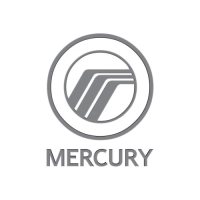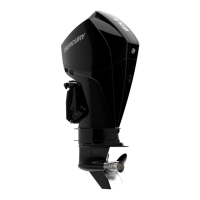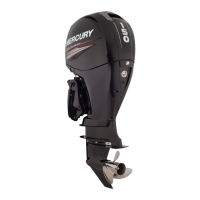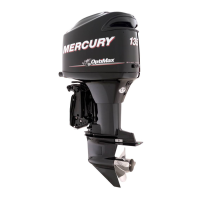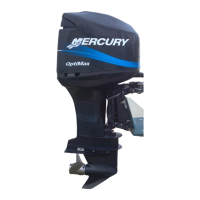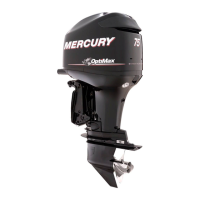Do you have a question about the Mercury 125 OptiMax and is the answer not in the manual?
Details engine types, fuel, and essential requirements for compliance.
Outlines requirements for exhaust emissions testing and documentation.
Outlines requirements for noise emissions testing and documentation.
Instructions for registering the product for warranty coverage in the US and Canada.
Procedure for transferring limited warranty coverage to a subsequent owner.
Details on transferring extended service coverage plans.
Specific warranty terms for Mercury Jet products.
Details what the Mercury Jet Products Limited Warranty covers.
Details the three-year warranty coverage for corrosion issues.
Explains what is covered and not covered under the warranty.
Lists specific items and conditions excluded from general warranty coverage.
Outlines the limited warranty for emission control systems per EPA regulations.
Lists components covered under the emission-related warranty.
Details warranty for emission control systems specific to California regulations.
Explains California's emission control warranty requirements.
Describes the meaning of different emission certification star labels.
Outlines the limited warranty policy for Australia and New Zealand.
Provides warranty coverage charts for various regions and product types.
Warranty coverage details for US models of outboards and jet drives.
Warranty coverage details for Canadian models of outboards and jet drives.
Specific warranty terms for racing products used recreationally.
Warranty coverage for outboards and jet drives in Australia and NZ.
Warranty coverage for outboards and jet drives in the South Pacific.
Warranty coverage for outboards and jet drives in Asian regions.
Warranty coverage for outboards and jet drives in Europe and CIS.
Warranty coverage for outboards and jet drives in the Middle East and Africa.
Warranty coverage for outboards and jet drives in South Africa.
Specifies the duration of warranty coverage from sale or service date.
Outlines prerequisites for obtaining warranty service.
Steps a customer must take to initiate a warranty claim.
Lists items and conditions explicitly excluded from warranty coverage.
Details disclaimers on implied warranties and limitations on damages.
Outlines the operator's duties for safe boat operation and manual understanding.
Advises careful reading of the manual and contacting dealer for questions.
Warns against exceeding the boat's maximum horsepower rating.
Recommends orientation for unfamiliar high-speed boats.
Discusses the importance of choosing the correct propeller for performance.
Mentions remote control features and the need for start-in-neutral protection.
Advises on proper fasteners for steering link rods to prevent disengagement.
Explains the function of the lanyard stop switch for safety.
Advises caution and slowing down when people are in the water.
Safety advice for passengers on pontoon and deck boats.
Warns about hazards associated with jumping waves or wakes.
Advises caution and speed control in areas with potential underwater obstacles.
Alerts to the dangers of carbon monoxide poisoning from exhaust fumes.
Recommends genuine accessories and checking compatibility before installation.
Provides general advice on boating safety, regulations, and checks.
Importance of recording the outboard's serial number for reference.
Provides technical specifications for the outboard models.
Provides technical specifications specific to the 80 Jet OptiMax model.
Illustrates and labels key external components of the outboard.
Describes the meaning of different emission certification star labels.
Instructions for safely trailering a boat with the outboard installed.
Guidelines on selecting and using the correct type of gasoline for the engine.
Specifies fuel types and conditions, avoiding premixed gas and oil.
Recommends using fuel stabilizers and cleaners for engine maintenance.
Important considerations for fuel system components to prevent flow issues.
Details EPA requirements for low permeation fuel hoses on US models.
Describes the functions and operations of Mercury Precision/Quicksilver remote controls.
Explains the different types of warning horns for engine status.
General operational notes and daily inspection reminders before use.
A list of checks to perform before starting the engine.
Precautions for operating the outboard in freezing conditions.
Recommendations for flushing the outboard after use in saltwater.
Notes on engine compensation for high elevation changes.
Guidance on trim angle to avoid exhaust restrictions at idle.
Critical procedures and suggestions for the engine's initial break-in period.
Step-by-step instructions for starting the engine safely.
How to properly shift gears using the outboard's control.
Procedure for safely shutting down the engine.
Specific operational guidance for jet drive models.
Importance of periodic inspections and maintenance for optimal condition and safety.
Recommends using genuine Mercury/Quicksilver parts and lubricants.
Certification details for EPA emissions compliance.
Detailed schedule for routine maintenance tasks before, during, and after use.
Procedures for preparing the outboard for out-of-season or prolonged storage.
Advises returning to authorized dealers for factory-trained service.
How to find service when away from your local dealer.
Where to direct inquiries for parts and accessories.
General assistance procedures for service needs.
Lists common causes and checks for engine not cranking.
Identifies potential issues when the engine fails to start.
Possible causes for inconsistent engine operation.
Reasons for reduced engine performance.
Troubleshooting steps for a battery that does not retain charge.
Specific troubleshooting for jet drive applications.
Information on using Mercury-approved fasteners for secure mounting.
Guidelines on mounting accessories without compromising engine security.
General notes regarding outboard installation complexity.
Warning about exceeding the boat's maximum horsepower rating.
Safety feature preventing engine start when in gear.
Guidance on fuel system setup and maintenance.
Important considerations for fuel system components to prevent flow issues.
Details on electric fuel pump pressure limits and regulators.
Details EPA requirements for low permeation fuel hoses on US models.
A table for recording performed maintenance and engine hours.
Specifies the duration of warranty coverage from sale or service date.
Outlines prerequisites for obtaining warranty service.
Steps a customer must take to initiate a warranty claim.
Lists items and conditions explicitly excluded from warranty coverage.
Details disclaimers on implied warranties and limitations on damages.
Describes the meaning of different emission certification star labels.
Guidelines on selecting and using the correct type of gasoline for the engine.
Specifies fuel types and conditions, avoiding premixed gas and oil.
Recommends using fuel stabilizers and cleaners for engine maintenance.
Important considerations for fuel system components to prevent flow issues.
Details EPA requirements for low permeation fuel hoses on US models.
Describes the functions and operations of Mercury Precision/Quicksilver remote controls.
Explains the different types of warning horns for engine status.
General operational notes and daily inspection reminders before use.
A list of checks to perform before starting the engine.
Precautions for operating the outboard in freezing conditions.
Recommendations for flushing the outboard after use in saltwater.
Notes on engine compensation for high elevation changes.
Guidance on trim angle to avoid exhaust restrictions at idle.
Critical procedures and suggestions for the engine's initial break-in period.
Step-by-step instructions for starting the engine safely.
How to properly shift gears using the outboard's control.
Procedure for safely shutting down the engine.
Specific operational guidance for jet drive models.
Importance of periodic inspections and maintenance for optimal condition and safety.
Recommends using genuine Mercury/Quicksilver parts and lubricants.
Certification details for EPA emissions compliance.
Detailed schedule for routine maintenance tasks before, during, and after use.
Procedures for preparing the outboard for out-of-season or prolonged storage.
Advises returning to authorized dealers for factory-trained service.
How to find service when away from your local dealer.
Where to direct inquiries for parts and accessories.
General assistance procedures for service needs.
Lists common causes and checks for engine not cranking.
Identifies potential issues when the engine fails to start.
Possible causes for inconsistent engine operation.
Reasons for reduced engine performance.
Troubleshooting steps for a battery that does not retain charge.
Specific troubleshooting for jet drive applications.
Information on using Mercury-approved fasteners for secure mounting.
Guidelines on mounting accessories without compromising engine security.
General notes regarding outboard installation complexity.
Warning about exceeding the boat's maximum horsepower rating.
Safety feature preventing engine start when in gear.
Guidance on fuel system setup and maintenance.
Important considerations for fuel system components to prevent flow issues.
Details on electric fuel pump pressure limits and regulators.
Details EPA requirements for low permeation fuel hoses on US models.
A table for recording performed maintenance and engine hours.
| Horsepower | 125 HP |
|---|---|
| Cylinders | 3 |
| Engine Type | 2-Stroke |
| Starting | Electric |
| Exhaust | Through prop |
| Lubrication System | Oil injection |
| Fuel System | Direct Fuel Injection (DFI) |
| Full Throttle RPM | 5000-5750 rpm |
| Alternator Output | 60 Amp |
| Shaft Length | 20" |
| Cooling System | Water-cooled |
| Weight | 180 kg (397 lbs) |
